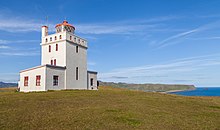Dyrhólaey



Dyrhólaey (Icelandic pronunciation: [ˈtɪrˌhouːlaˌeiː], "door hill island"), formerly known by seamen as Cape Portland,[1] is a small promontory located on the south coast of Iceland, not far from the village Vík. In fact, Dyrhólaey is the southernmost point in mainland Iceland. It was formerly an island of volcanic origin, which is also known by the Icelandic word eyja meaning island. The volcano erupted about 100 thousand years ago during the Pleistocene.[2] The peninsula has an elevation of 120 metres (390 ft),[3] and the Dyrhólaey Lighthouse sits at the top of the formation facing the sea.[4]
The view from Dyrhólaey is broad: To the north is to be seen the big glacierMýrdalsjökull . To the east, the black lava columns of the Reynisdrangar come out of the sea, and to the west the whole coastline in the direction of Selfoss is visible – depending on weather conditions. In front of the peninsula, there is a gigantic black arch of lava standing in the sea, which gave the peninsula its name (meaning: door hill island).[5]
In the summertime, many Atlantic puffins can be found nesting on the cliff faces of Dyrhólaey.[6]
Contents
See also
References
- Journey to the Center of the Earth: Chapter IX. Iceland! But What Next?
- https://www.katlageopark.com/geosites/dyrholaey/
- Harlow, Cathy (2004). Iceland. Hunter Publishing, Inc. ISBN978-1-84306-134-2. Retrieved 23 May 2018 .
- "Foghorn Publishing ... Lighthouse Explorer Database ... Dyrhólaey Light > Lighthouse Digest". Lighthouse Digest. Retrieved 20 May 2019.
- Dalton, Anthony (2003). Wayward Sailor: In Search of the Real Tristan Jones. McGraw Hill Professional. ISBN978-0-07-140251-4. Retrieved 23 May 2018 .
- Evans, Andrew (2008). Iceland. Bradt Travel Guides. ISBN978-1-84162-215-6. Retrieved 23 May 2018 .
External links